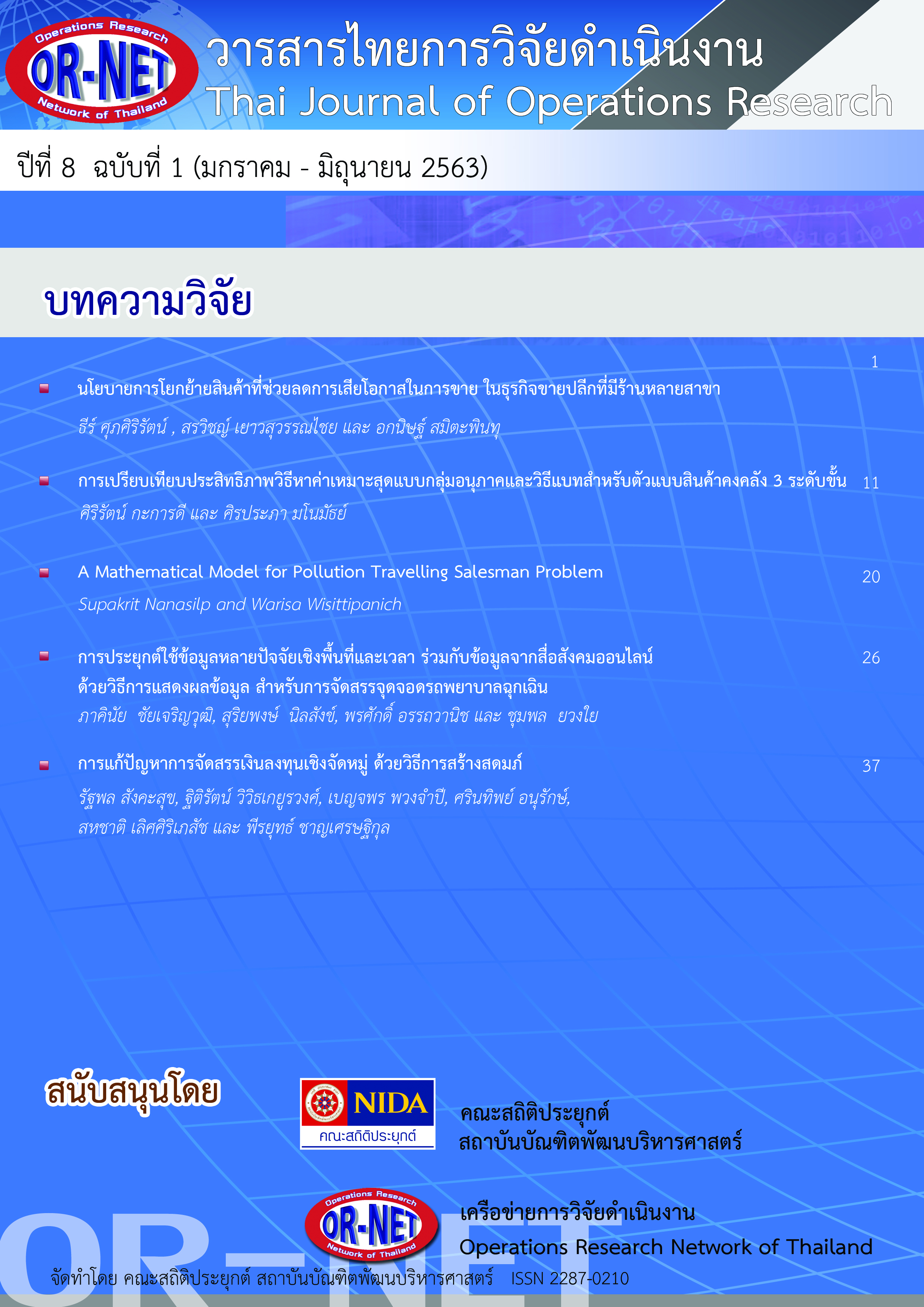Multiple Spatial-Temporal factors with Social Network information using Data Visualization for Emergency Ambulance Base Locations
Keywords:
Emergency Medical Service, covering model, kernel density estimation, social network data, spatial-temporal dataAbstract
The Emergency Medical Service (EMS) are very important for helping wounded people or victims from the situation either from people or the natural disasters. Hence, the quickly access to those who have been a wounded people is very significant. To access into the scene of the accident have time to acceptable the response time is 8 minutes to increase more opportunities or reduce disability of wounded people. Therefore, allocating an emergency ambulance base for quick access to the accident area is very important. Currently, the emergency medical service allocates emergency ambulance base at hospitals. By using experts or past information to make decisions In this study, the application of data from social media and spatial data and time showing the thickness of each area for receiving emergency medical services using heatmap Visualization by the kernel density estimation method And use the highest-density high-density and medium-density results to force the selection in the mathematical model, also known as the covering model, in deciding the emergency ambulance base allocation in Bangkok, which is a case study in This time As for the results from this case study, the method proposed is to reduce emergency parking spaces that are more than necessary by 20%, increase coverage area of 2.72%, and increase service coverage by 1%.
References
[2] ส. คูชัยสิทธิ์, “การเข้าสู่โลกยุคใหม่ของข้อมูล ‘บิ๊กดาต้า,’” วารสารนักบริหาร, vol. 33, no. 1, pp. 22–28, 2556.
[3] M. Martínez-Rojas, M. del C. Pardo-Ferreira, and J. C. Rubio-Romero, “Twitter as a tool for the management and analysis of emergency situations: A systematic literature review,” Int. J. Inf. Manage., vol. 43, no. August, pp. 196–208, 2018.
[4] C. S. Lim, R. Mamat, and T. Braunl, “Impact of ambulance dispatch policies on performance of emergency medical services,” IEEE Trans. Intell. Transp. Syst., vol. 12, no. 2, pp. 624–632, 2011.
[5] X. Li, Z. Zhao, X. Zhu, and T. Wyatt, “Covering models and optimization techniques for emergency response facility location and planning: A review,” Math. Methods Oper. Res., vol. 74, no. 3, pp. 281–310, 2011.
[6] P. Tran, R. Shaw, G. Chantry, and J. Norton, “GIS and local knowledge in disaster management: A case study of flood risk mapping in Viet Nam,” Disasters, vol. 33, no. 1, pp. 152–169, 2009.
[7] L. S. Prague, “Kernel Density Estimations for Visual Analysis,” no. January 2010, 2016.
[8] Y. Lu, X. Hu, F. Wang, S. Kumar, H. Liu, and R. Maciejewski, “Visualizing social media sentiment in disaster scenarios,” WWW 2015 Companion - Proc. 24th Int. Conf. World Wide Web, pp. 1211–1215, 2015.
[9] S. Nilsang, C. Yuangyai, C. Y. Cheng, and U. Janjarassuk, “Locating an ambulance base by using social media: a case study in Bangkok,” Ann. Oper. Res., pp. 1–20, 2018.
[10] P. Chaicharoenwut, J. Koiwanit, P. Changpetch, S. Buatongkue, and C. Yuangyai, “Integrating Spatial-Temporal Risk Factors for an Ambulance Allocation Strategy: A Case Study in Bangkok,” in MATEC Web of Conferences, 2018, vol. 192, pp. 1–4.
[11] B. W. Silverman, “Density estimation: For statistics and data analysis,” Density Estim. Stat. Data Anal., no. 1951, pp. 1–175, 2018.
[12] M. Yiampisan and M. Srivanit, “Using the Kernel Density Estimation Surface for Criminal Pattern: A Case Study in Phranakhon District, Bangkok,” no. December, pp. 87–102, 2010.
[13] T. Srithamarong, “CRIME RISK AREA ASSESSMENT BASED GEO-SPATIAL STATISTICS,” Silpakorn University, 2016.
[14] G. Borruso, “Network density estimation: A GIS approach for analysing point patterns in a network space,” Trans. GIS, vol. 12, no. 3, pp. 377–402, 2008.
[15] L. B. Toregas, C., C. ReVelle, “The location of emergency service facilities. Operations Research,” 1971.
[16] S. Nilsang, “Allocation strategy for an ambulance base under traffic congestion,” in MATEC Web of Conferences, 2018, pp. 1–4.
[17] สำนักยุทธศาสตร์และประเมินผล, สถิติ 2559 กรุงเทพมหานคร. กรุงเทพมหานคร, 2559.
[18] INRIX, “Inrix_Trafficscorecard_Global_En_Lr-2017,” 2017.
[19] กรมการเเพทย์ฉุกเฉิน, “ข้อมูลทรัพยากรพื้นฐาน ที่ขึ้นทะเบียนในระบบสารสนเทศการแพทย์ฉุกเฉิน (ITEMS,” 2019. [Online]. Available: http://report.niems.go.th/niemsdwh/portal_link.html.




